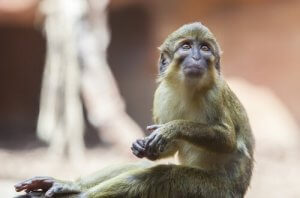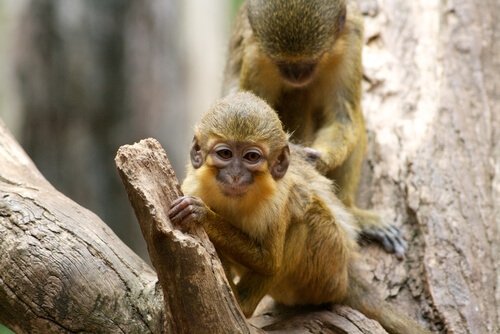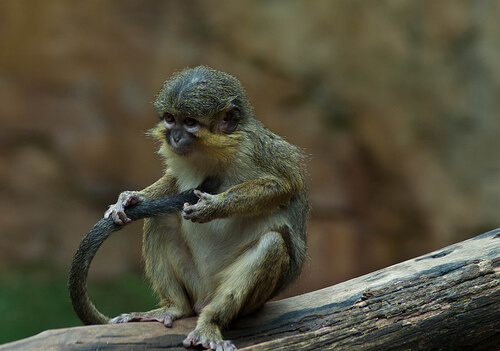Talapoin Monkeys: Characteristics, Behavior and Habitat


Written and verified by the vet Eugenio Fernández Suárez
Talapoin monkeys are a species of primate that scientists don’t know too much about. Unfortunately, the ones that live in Europe are still victims of illegal animal trafficking.
Talapoin monkey characteristics
There are two different types of talapoin monkeys, and they’re from the Miopithecus genus. These monkeys live in the center of Africa. The two types are the Angolan talapoin and the Gabon talapoin.
Both are small primates that weigh around 2 pounds and are 15 inches long. That makes them the smallest African monkey. However, there are several species of marmoset, which are found in South America, that are much smaller than them.
They look similar to green monkeys, but they’re much smaller. Green monkeys can weigh between six and eight times more than this small African primate. They also have a brown coat with greenish tones, especially in the back and head area. This is what makes them look like green monkeys.
These monkeys also have a recognizable furless face, and this makes it easy to see their facial expressions.
The northern Gabon talapoin has flesh-color skin on its face. Whereas the skin and the ears on the southern Angolan talapoin are black.

The mothers carry their babies for about five months before giving birth. After just six weeks, the baby will be able to eat solid foods. It’s normal for primates to only have one offspring and the mothers are known for taking great care of their young. Additionally, these animals can live between 20 and 30 years, especially in captivity.
Talapoin monkey behavior
Talapoin monkeys live in large groups of up to 100 individuals, and all of these members usually sleep in trees together. However, during the day, they usually divide into small groups to look for food. That way, they’ll avoid any conflicts over what they find.
The groups have a lot of males and females with their young. They’re animals that lack territorial behavior and have a large vocal repertoire. However, their repertoire is not as great as that of other monkeys.
Talapoin monkeys are omnivores, so they feed on fruits and seeds, as well as aquatic plants or eggs, insects and other invertebrates. They will also eat small rodents and birds, but not as often.
Although they’re both tree-based, it seems that the Angola talapoin is more terrestrial than the Gabon type. Scientists believe this may be due to the differences in the resources in each particular ecosystem.

Habitat of Talapoin monkeys
Talapoin monkeys are primates that like to live around trees, and they’re a diurnal animal that only lives in forests and thicker jungles. Interestingly, it’s one of the few primates that has no problems with getting wet, and they will even swim to find food.
Because of this, this primate usually lives in areas near bodies of water. The Gabon talapoin monkeys live in the coastal areas of Cameroon, Equatorial Guinea, Gabon and the Democratic Republic of the Congo.
The southern talapoin, however, lives in the Miombo. This is a type of wooded savanna that’s located in the southern cone of Africa, and is a lot drier than the area where the Gabon talapoin lives. In particular, the Angola talapoin lives in the south of the Congo River, in the Republic of the Congo river and in Angola.
Although the talapoin species aren’t in danger, they’re not very well protected from illegal trafficking. Since they’re so small, they can easily be captured and sold in Europe as pets. African primates in central Africa are especially dangerous for humans. That’s because they live in an area where there are important and dangerous zoonoses, which aren’t controlled in animals that come to Europe illegally.
This text is provided for informational purposes only and does not replace consultation with a professional. If in doubt, consult your specialist.